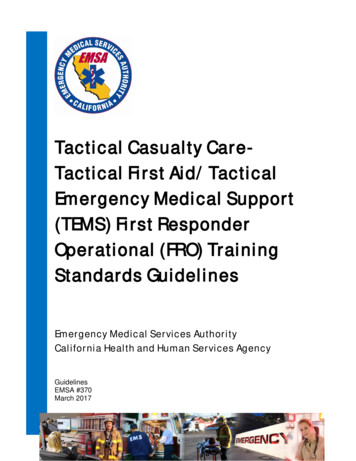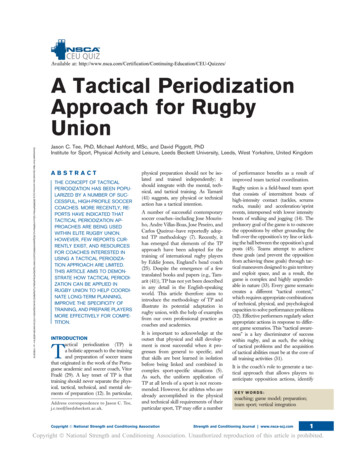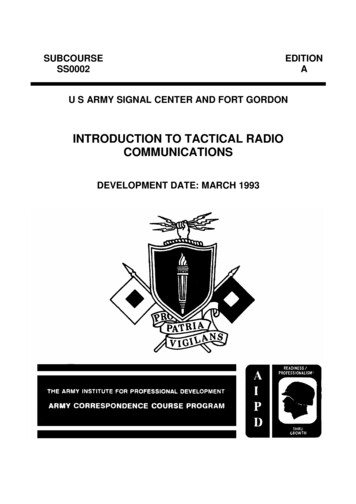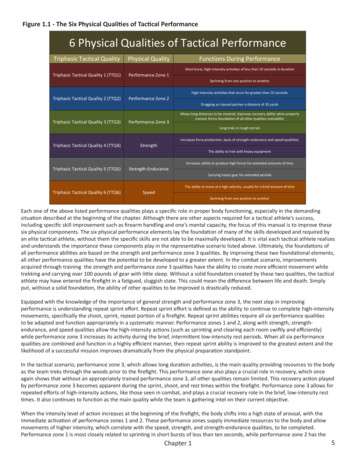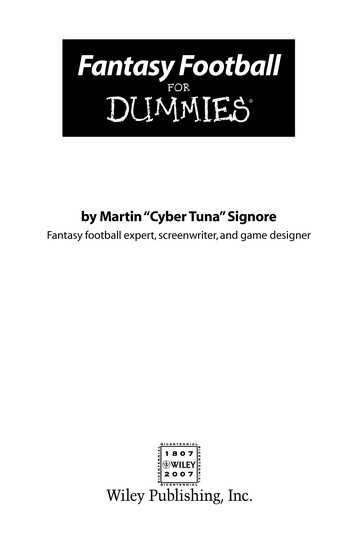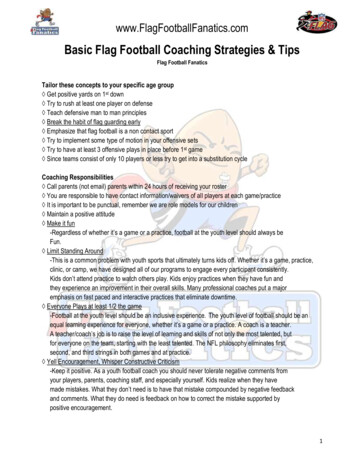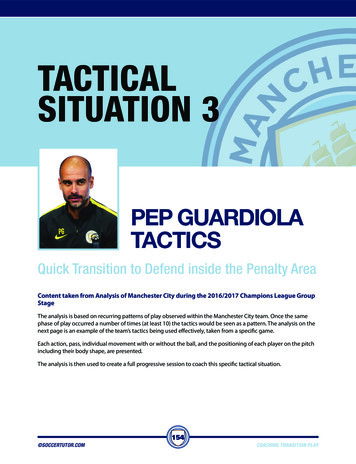
Transcription
TACTICALSITUATION 3PEP GUARDIOLATACTICSQuick Transition to Defend inside the Penalty AreaContent taken from Analysis of Manchester City during the 2016/2017 Champions League GroupStageThe analysis is based on recurring patterns of play observed within the Manchester City team. Once the samephase of play occurred a number of times (at least 10) the tactics would be seen as a pattern. The analysis on thenext page is an example of the team’s tactics being used effectively, taken from a specific game.Each action, pass, individual movement with or without the ball, and the positioning of each player on the pitchincluding their body shape, are presented.The analysis is then used to create a full progressive session to coach this specific tactical situation.154 SOCCERTUTOR.COMCOACHING TRANSITION PLAY
Tactical Analysis of PEP GUARDIOLA - Transition from Attack to Defence (Low Zone)Analysis Taken from ‘Manchester City vs FC Barcelona - 1 Nov 2016’Quick Transition to Defend Inside the Penalty AreaIn this situation Man Cityare building up play fromthe goalkeeper.The centre backOtamendi receives andcarries the ball forward.He is closed down byNeymar and passesforward to Sterling (7).Sterling (7) takes a badtouch and the ball isintercepted by Busquets(5). Busquets (5) passesto Rakitic, who passes toSuarez (9).Man City now need tomake a quick transitionfrom attack to defence.Suarez passes to Neymar.Zabaleta (5), Sterling (7)and Otamendi (30) allmove quickly to closedown the new ball carrier(Neymar) who dribblesforward with the ball. Theother Man City playersquickly track back, with 5players in total defendinginside the penalty area.Neymar attempts a lowcross - Kolarov has movedacross and clears the balltowards Aguero.This is an example of asuccessful transition fromattack to defence for PepGuardiola's Man City.155 SOCCERTUTOR.COMCOACHING TRANSITION PLAY
Session to Practice PEP GUARDIOLA Tactics - Transition from Attack to Defence (Low Zone)PROGRESSION2. Quick Transition to Defend 1 v 1 inside the Penalty Areawithin a Dynamic 8 v 8 SSGDescriptionUsing half a pitch we create a playing zone approximately 35 x 55 yards. We have 2 full size goals and play anormal 8 v 8 game within the zone. The teams can use the same or different formations and all players arenumbered (1 to 7). We also have a goal and a goalkeeper in the normal position with 2 players (yellow) near thesidelines, ready to cross balls into the penalty area.The practice starts with one of the team's goalkeeper (blue in diagram) and we play a normal 8 v 8 game. Whenone team finishes an attack, the coach calls out a number and a side (e.g. ‘4 - Right’). The 2 players who have theirnumbers called out then quickly run into the penalty area for a 1 v 1 duel.The cross is delivered from the side that the coach calls out (left or right). The player from the team that justfinished their attack makes a transition from attack to defence (blue No.4 in diagram), trying to prevent theopponent from scoring. The opposing No.4 (red) tries to score.Once the 1 v 1 is finished, the practice starts again in the main zone from the red team's goalkeeper, with theteam roles and objectives reversed.Coaching Points1. The player in transition from attack to defence needs to have quick reactions and make sure to get intoposition inside the penalty area before the opposing attacker.2. The defender should get goal side of the attacker and side-on to the ball, before making a clearance.158 SOCCERTUTOR.COMCOACHING TRANSITION PLAY
Session to Practice PEP GUARDIOLA Tactics - Transition from Attack to Defence (Low Zone)PROGRESSION3. Press, Win the Ball, Switch the Point of Defence and QuickTransition to Defend inside the Penalty AreaScenario 1:When the red team start in possessionDescriptionIn this progression of the previous practice, we now use the full width of the pitch and create a zone from theedge of the penalty area to the halfway line and mark out 3 small goals with large cones as shown in the diagram.Within the main zone we have a 6 v 6 situation with the blue team in a 4-2 formation against the red team whoare in a 4-1-1 or 2-3-1 formation. The red team also have 3 extra players (numbered randomly 1-3) with a ball inthe 3 small cone goals on the halfway line.The practice starts with the red team in possession trying to create chances and score a goal. If the blue team winthe ball, the coach then calls out a number and that outside red player (1, 2 or 3) immediately runs into the zonewith a new ball. The red team then have 12-14 seconds to finish their attack.After winning the ball in the first phase, the blue team must then change immediately back to defending again.They must defend their goal with a numerical disadvantage (6 v 7).If the blue team are able stop the attack or win the ball in the second phase, the coach calls out which yellow player willcross the ball (right or left). At this point, all of the players are allowed to enter the penalty area. The reds attack and tryto score. The blues are again in a transition from attack to defence and try to defend their goal - See Page 161.159 SOCCERTUTOR.COMCOACHING TRANSITION PLAY
Session to Practice PEP GUARDIOLA Tactics - Transition from Attack to Defence (Low Zone)Scenario 2:When the blue team start in possession1/2DescriptionIn this second scenario, it is the blue team that now start in possession.The practice starts with the blue team's goalkeeper who passes to one of the defenders, as shown in the diagram.The blue team build up play and try to find solutions to score in one of the 3 small cone goals on the halfway line(1 point).If the blue team score or the attack finishes, then the coach calls out a number and that outside red player (1, 2 or3) immediately runs into the zone with a new ball. In this example it is red No.3 and the red team then have 12-14seconds to finish their attack.After scoring or finishing their attack in the first phase, the blue team must then change immediately backto defending again. As a new player and ball enter the pitch, they must defend their goal with a numericaldisadvantage (6 v 7).The description of scenario 2 continues with the diagram on the next page.160 SOCCERTUTOR.COMCOACHING TRANSITION PLAY
Session to Practice PEP GUARDIOLA Tactics - Transition from Attack to Defence (Low Zone)2/2This diagram is a continuation of scenario 2. The red outside player(No.3) has dribbled into play to start a newattack.If the blue team are able to stop the attack or win the ball in this second phase, the coach calls out which yellowplayer will cross the ball (right or left). At this point, all of the players are allowed to enter the penalty area. Thereds attack and try to score. The blues are in a transition from attack to defence again and try to defend the goal.Rules (for Scenarios 1 & 2)1. All players have unlimited touches.2. As soon as an outside red player enters with a ball, the red team have 12-14 seconds to finish their attack.3. As soon as the coach calls out which yellow player is to cross (right or left), the red team have 6 seconds tofinish their attack.4. If the red team score a goal they get 1 point.5. If the blue team stop an attack or win the ball they get 1 point.6. If the blue team score in one of the 3 small cone goals on the halfway line (scenario 2), they get 2 points.Coaching Points1. There needs to be good defensive organisation and movements in our own half after losing possession. Limitthe space and time available for the opposition - prevent them from creating goal scoring opportunities.2. Players need to position themselves in central areas to guard the ‘danger zone’ in case the opposition are ableto pass into the penalty area.3. Press the ball and mark tightly - prevent the opposition scoring within 8 seconds, then try to recover the ball.161 SOCCERTUTOR.COMCOACHING TRANSITION PLAY
Football Coaching Specialists Since 2001BUY NOWAvailable in Full Colour Print and eBook!PC Mac iPhone iPad Android Phone/Tablet Kobo Kindle FireFREECOACHVIEWER www.SoccerTutor.comAPP info@soccertutor.com
TACTICAL SITUATION 3 PEP GUARDIOLA TACTICS Content taken from Analysis of Manchester City during the 2016/2017 Champions League Group Stage The analysis is based on recurring patterns of play observed within the Manchester City team. Once the same phase of play occurred a number of ti

